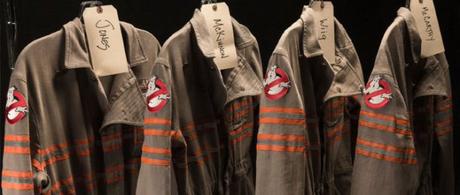
One of the lessons from this year's summer box office is that you really shouldn't spend sequel money on a non-sequel unless the world really, really wants what you have to offer. However, right now the world mostly just wants animated movies about talking animals and anything distributed by Disney (except Alice Through the Looking Glass). So, unless you have the Disney banner flying over your head maybe you should think twice before authorizing an exorbitant budget for your latest franchise-starter (or re-starter). Warner Bros. is currently learning that with The Legend of Tarzan, and now Sony is in complete public denial about it with Paul Feig's Ghostbusters reboot.
To recap, Tarzan grossed a higher-than-expected $46.5 million over the July 4th holiday, and just crossed $100 million domestic in this its third weekend. It has yet to dip out of the top 3 in the weekly top 10, and is c urrently the second highest-grossing non-superhero/animated film of the summer. Worldwide, it's up to $193m, and it hasn't even opened in the world's second (China), fourth (Japan) and fifth (India) leading markets for film yet.
But it doesn't matter because t he film's already considered a financial failure. WB all but guaranteed as much by allowing director David Yates to run the production budget up to $180m, which is superhero movie territory. By doing so, the studio ensured Legend would have to become the highest-grossing Tarzan film of all time just to break even, as argued in more detail by Forbes. As a point of comparison, when Fox decided to reboot the Planet of the Apes franchise it committed a mere $93m on its proof-of-concept first film (2011's Rise of the Planet of the Apes). Once that became a surprise hit (worldwide gross of $481m) they nearly doubled the budget for the sequel (2014's Dawn of the Planet of the Apes, which cost $170m and grossed $710m worldwide).
WB didn't necessarily have to mimic that strategy with Tarzan. What Fox did with Apes, specifically the budgets, was more extreme than most. However, WB already had a more fiscally prudent model for reintroducing a once-great, now-tarnished franchise, chiefly the way they once spent $150m on Batman Begins and then $185m on The Dark Knight. However, they jumped straight to Dark Knight territory for Tarzan, and as a result Alexander Skarsgard's days of swinging shirtless from vine to vine in the jungle are probably already over. Of course, if he wants to keep doing that and releasing footage of it we're not going to stop him because, well, he's just so pretty.
Interestingly, the man responsible for rebooting Planet of the Apes in such a cost conscious way at Fox is now the one guilty of overspending on the Ghostbusters reboot at Sony. But it's a little more complicated on that.
First, the numbers: Ghostbusters debuted to $46m this weekend, dang near smack dab in the middle of the $40m-$50m pre-release projections. As Sony has been quick to point out, that ranks as:
- A career high opening for Paul Feig, Katie Dippold, Melissa McCarthy, Leslie Jones, Kate McKinnon, Cecily Strong, and Andy Garcia
- The biggest live-action comedy debut since Pitch Perfect 2's $69m back in May of 2015
- Second biggest live-action/non-superhero opening of the year behind Walt Disney's The Jungle Book (which is only live-action in the sense that Mowgli is real; everything else around him is CGI).
- The third-biggest live-action opening of the summer behind X-Men: Apocalypse and Captain America: Civil War
Sony's president of worldwide marketing and distribution proudly declared, "We are ecstatic with this opening. We have successfully restarted an important brand." However, and all beg to differ, with box office analyst Jeff Bock telling THR:
I know Sony is crowing about it being a great opening for a comedy, but the entire Ghostbusters legacy is what's at stake here, and it's not looking good. This was supposed to be a blockbuster. Sony definitively did not launch a franchise, and seemingly they might be the only ones that don't know it.
This is partially a problem current Sony Pictures Entertainment Chairman Tom Rothman inherited from his predecessor Amy Pascal. She greenlit Ghostbusters with a hefty $169m budget, including non-negotiable talent deals for Melissa McCarthy ($14m) and Paul Feig (north of $10m). There was nothing Rothman could do about the salaries, but his days as Fox Chairman from 1994 to 2012 were characterized by shrewd, sometimes outright thrifty spending and the best profit margins of any studio in town. In his first months on the job at Sony in early 2015 he cut the fat by canceling multiple films with limited profit potential, and hacked away at the Ghostbusters script to trim the budget. He managed to bring it down to $154m, which the producers were then able to bring down to $144m after tax rebates and incentives.
By blockbuster standards, that might seem like a reasonable spend, especially when I've already chastised WB for allowing Legend of Tarzan's budget to climb to $180m. However, you have to take the genre into consideration. $144m is not the type of money any studio would normally spend on a comedy. The most recent comparison would be Sony's own Pixels, which cost $88m and was considered a big budget comedy. Paul Feig's prior movies ( Bridesmaids, The Heat, and Spy) have all been relatively economical ($32.5 million, $43 million, and $65 million, respectively) by comparison.
So, what the hell was Amy Pascal thinking greenlighting a $170m Ghostbusters movie that her more frugal replacement was only able to get down to $144m? As Vulture argued (by diving into Pascal's hacked emails), she wanted to start her own Marvel cinematic universe. Feig's Ghostbusters is supposed to kickstart a wide range of spin-offs, sequels and TV shows, and Pascal and her president of production at the time Michael De Luca thought that to do that they needed to spend superhero money. All of Marvel's origin story movies cost around $130m-$170m, with Ant-Man on the low-end and Guardians of the Galaxy on the high. In a pre- Deadpool world, that seemed like the minimum cost of entry.
On the one hand, it's admirable that a Hollywood studio committed so much money to a female-led horror comedy. On the other hand, though, it might have been a complete misreading of the franchise's value, the tastes of the market and the type of genre they were working in. Maybe $144m (after rebates) is what you spend on the Ghostbusters sequel, not the first one. By lumping Ghostbusters into such an elite tax bracket Sony might have crossed the streams straight out of the gate.
Now, Ghostbusters is stuck with a series of so-so reviews, a similarly so-so B+ CinemaScore and has to contend with S tar Trek Beyond, Jason Bourne, Bad Moms and Suicide Squad over the next three weeks. Plus, as an American comedy its international prospects are a complete mystery. For the record, of Paul Feig movies only Spy managed to gross more internationally ($122m) than domestically ($1110m). Nneither of the first two Ghostbusters pulled off that trick, although we live in a far, far different world these days.
 So, what can we expect from Ghostbusters at the box office the rest of the way? Forbes broke down the best-case and worst-case scenarios, domestically:
So, what can we expect from Ghostbusters at the box office the rest of the way? Forbes broke down the best-case and worst-case scenarios, domestically:
The worst-case scenario is that it plays like The Boss ($63m/$23.5m) or Sex Tape ($38m/$14m) and ends up with $125 million domestic and thus desperately needs overseas grosses to survive. But the rest of the comparisons are a bit rosier.
Even Sony's Pixels, which was terrible in almost every way (sorry), pulled a 3.25x weekend-to-final multiplier ($78 million/$24m) which would give Ghostbusters a robust $152m cume. If it plays like The Heat ($159m/$39m), Identity Thief ($134m/$29m), Spy ($110m/$29m), 21 Jump Street ($138m/$36m), or, uh, Ghostbusters 2 ($112m/$29m), it gets somewhere between $178m and $190m.
That gives us a range of $125m to $190m, but that's just domestic. How much does this movie need to make worldwide just to break even?
The rule of thumb is that a movie can be considered profitable if it doubles its budget in worldwide gross. In a recent analysis of the full financials for 29 blockbusters with a minimum budget of $100 StephenFollows.com discovered this rule of thumb is actually accurate 83% of the time. The other 17% of the time the film needs to do far more than merely double its budget. If Ghostbusters falls into the 83% category it will need to reach $288m worldwide to at least break even, but says the break-even point is actually a bit higher, "Insiders estimate that it will have to do at least $300 million globally to break even and substantially more than that to justify a sequel."
And it will have to do that without China since the country's film commission has a thing against films dealing with ghosts.
Good luck.
Maybe making new Tarzan and Ghostbusters movies should have been complete non-starters, obvious bad ideas which should have never left the pitch stage. As films, they both have their strong suits, but as big budget gambles they both took far bigger swings than necessary.

